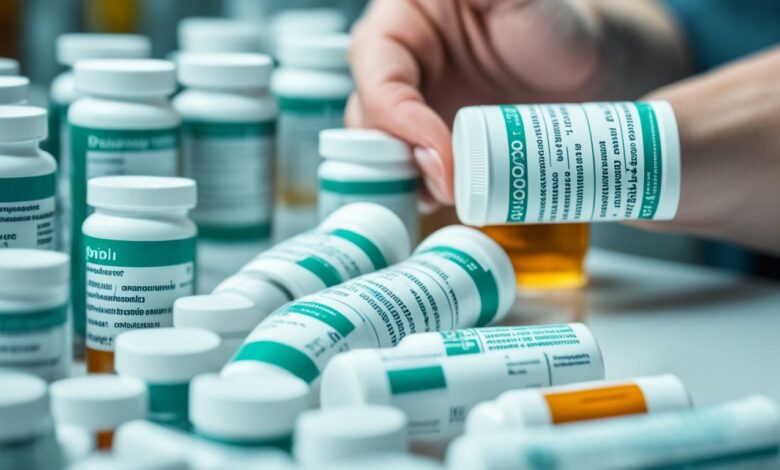Recognizing Opioid Use Disorder Signs & Symptoms

In people under 50, opioids are now the top cause of death. They beat out car accidents. This fact shows how important it is to spot opioid addiction and its signs early. The tricky part is that this condition often starts quietly, seeming like normal pain management or just for fun.
Both the body and mind can quickly depend on opioids without users or their families noticing. That’s why it’s crucial to watch out for any warning signs. Changes in how a person acts or if they often seem out of it can be key clues. We’re diving deep into opioid addiction to reveal the critical signs that could save a life.
Understanding Opioid Use Disorder and Its Prevalence
Opioid Use Disorder (OUD) often starts with the misuse of weaker drugs. It can lead to the abuse of stronger opioids. This issue harms the individual and affects millions worldwide. Spotting the signs of opioid addiction early is crucial to stop the slide into dependence.
The Progressive Nature of Substance Use Disorder
Many times, opioid addiction begins with prescribed medications or casual use of painkillers. This can slowly turn into a dependence. The key is knowing how addiction progresses to spot identifying opioid addiction signs early.
Scope of Opioid Addiction: Global and National Impact
The opioid crisis is a major global health issue today. Symptoms of opioid addiction hinder lives around the world. Over 16 million people suffer from it globally, with more than 2.1 million in the United States alone. Its widespread nature makes it comparable to other major health problems.
Opioid Dependence vs. Opioid Addiction
Distinguishing between opioid dependence and addiction is essential for recovery. Dependence comes with increased tolerance and withdrawal symptoms. On the other hand, addiction is the compulsive use of opioids despite the negative effects on one’s life.
| Opioid Dependence | Opioid Addiction |
|---|---|
| Increased tolerance to opioids | Compulsive use despite harm |
| Experiencing withdrawal symptoms | Failed attempts to cut down or control use |
| Physical reliance on opioids to function normally | Continued use despite social or interpersonal problems |
| Often a result of long-term prescribed use | Behavior revolving around opioid acquisition and use |
To combat OUD, it’s crucial that everyone identifies opioid abuse signs. This allows for the right help and support. By understanding OUD better, we can reduce its impact and improve care for those affected.
What Are the Signs and Symptoms of Opioid Use Disorder?
Finding signs of opioid use early is key to stopping the disorder from getting worse. Knowing all the signs and when to step in is crucial.
Physical Indicators of Opioid Misuse
Physical signs are the first clues we might notice. Common ones include:
- Constricted, small pupils
- Noticeable decrease in breathing rate
- Unresponsiveness to stimuli
- Non-specific flu-like symptoms
- Unexplained weight changes
- Frequent wearing of long sleeves to possibly conceal marks
Close ones or doctors who know what to look for can spot these signs.
Behavioral Changes Associated with Opioid Abuse
Behavioral changes might start small but get obvious as the problem grows. Important signs are:
| Behavioral Changes | Examples |
|---|---|
| Pronounced alterations in personality or mood | Increased irritability, mood swings, being frequently agitated |
| Avoidance of social interactions | Declining invitations, isolating from friends and family |
| Decline in performance | Lack of efficiency at work, falling grades in school |
| Changes in interests | Losing interest in hobbies or activities once enjoyed |
| Secretive behavior | Being elusive about whereabouts, friends, or activities |
| Legal or financial issues | Unexpected debts, possession of stolen items |
Seeing these behavioral changes should make us worried, especially if they appear suddenly.
Recognizing Advanced Warning Signs of Opioid Use
In serious cases, the warning signs are more dangerous. Advanced indicators include:
- Medications going missing without explanation
- Burnt spoons or other paraphernalia indicative of drug use
- Absence of household items like shoelaces, possibly used as tourniquets
- Presence of syringes, needles, or small plastic bags with powder residue
Spotting these signs means it’s time to act fast. Recognizing them not only points to opioid misuse but also leads to getting the right help.
It’s vital for everyone to understand opioid use disorder signs. This way, we can tackle this health issue together with care and effectiveness.
Diagnostic Criteria and Treatment Approaches for Opioid Use Disorder
To find out if someone has Opioid Use Disorder (OUD), doctors look at many signs. These include wanting opioids badly, using them a lot, pulling away from friends and family, and having troubles at work or home. If someone shows six or more of these signs, their case is considered severe.
Diagnosing OUD needs a detailed checkup. It involves testing, like urine tests, and understanding the person’s past with drugs, any injuries, and their mental health. After knowing for sure it’s OUD, deciding the right treatment is the next step. Treatments often combine meds such as methadone, buprenorphine, and naltrexone with therapy.
| Drug | Purpose | Application |
|---|---|---|
| Methadone | Prevents withdrawal symptoms | Administered daily in a clinic |
| Buprenorphine | Decreases cravings and withdrawal symptoms | Prescribed or dispensed in various settings due to the MAT Act |
| Naltrexone | Blocks euphoric effects of opioids | Taken orally or as a monthly injection |
The Mainstreaming Addiction Treatment (MAT) Act changed how we fight opioid addiction. It removed some rules, making it easier to get important medicines like buprenorphine. Now, doctors can help more people better, attacking the heart of the opioid crisis with new plans.
Conclusion
Opioid Use Disorder (OUD) is a huge problem for those affected, their families, and their communities. It’s vital to know the signs of opioid misuse early on. This helps stop the worst effects of this crisis.
We need to raise awareness and understand how deep OUD’s effects go. This can lead to better health results for everyone.
Improving health for people with OUD takes a group effort. Doctors, lawmakers, and support groups must work together. This includes using new ways to diagnose and treat this issue. The MAT Act is a big step towards helping those in need.
Our goal is to help people break free from opioid addiction. With better access to treatment and ongoing support, there’s hope. By working hard, we can fight OUD and make recovery a real goal for many.








